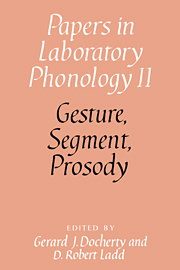Book contents
- Frontmatter
- Contents
- List of contributors
- Acknowledgments
- Introduction
- Section A Gesture
- 1 An introduction to task dynamics
- 2 “Targetless” schwa: an articulatory analysis
- 3 Prosodic structure and tempo in a sonority model of articulatory dynamics
- 4 Lenition of |h| and glottal stop
- 5 On types of coarticulation
- Section B Segment
- Section C Prosody
- Appendix 1 The test phrases (bold type) of experiment 1 in the context in which they were read
- Appendix 2 The distractors (bold type) of experiment 1 in the context in which they were read
- Appendix 3 The test sentences of experiment 2. The test words are in bold type
- Appendix 4 The distractor sentences of experiment 2. The distractors are in bold type
- References
- Name index
- Subject index
5 - On types of coarticulation
from Section A - Gesture
Published online by Cambridge University Press: 18 December 2009
- Frontmatter
- Contents
- List of contributors
- Acknowledgments
- Introduction
- Section A Gesture
- 1 An introduction to task dynamics
- 2 “Targetless” schwa: an articulatory analysis
- 3 Prosodic structure and tempo in a sonority model of articulatory dynamics
- 4 Lenition of |h| and glottal stop
- 5 On types of coarticulation
- Section B Segment
- Section C Prosody
- Appendix 1 The test phrases (bold type) of experiment 1 in the context in which they were read
- Appendix 2 The distractors (bold type) of experiment 1 in the context in which they were read
- Appendix 3 The test sentences of experiment 2. The test words are in bold type
- Appendix 4 The distractor sentences of experiment 2. The distractors are in bold type
- References
- Name index
- Subject index
Summary
Introduction
With few exceptions, both phonetics and phonology have used the “segment” as a basis of analysis in the past few decades. The phonological segment has customarily been equated with a phonemic unit, and the nature of the phonetic segment has been different for different applications. Coarticulation has, on the whole, been modeled as intersegmental influences, most frequently for adjacent segments but also at a greater distance, and the domain of coarticulatory interactions has been assumed to be controlled by cognitive (language-specific, structural, phonological) factors as well as by purely mechanical ones. As such, the concept of coarticulation has been a useful conceptual device for explaining the gap between unitary phonological representations and variable phonetic realizations. Less segment-based views of phonological representation and of speech production/perception have led to different ways of talking about coarticulation (see, for example, Browman and Goldstein, this volume).
We are concerned here with examining some segment-based definitions of coarticulation, asking some questions about the coherence of these definitions, and offering some experimental evidence for reevaluation of terminology.
Ways of measuring coarticulation
Previous studies show a general agreement that coarticulation consists of intersegmental influences. However, different studies have used different approaches to measuring these influences. We will compare two of these approaches. One could be called “testing for allophone separation.”
- Type
- Chapter
- Information
- Gesture, Segment, Prosody , pp. 128 - 146Publisher: Cambridge University PressPrint publication year: 1992



